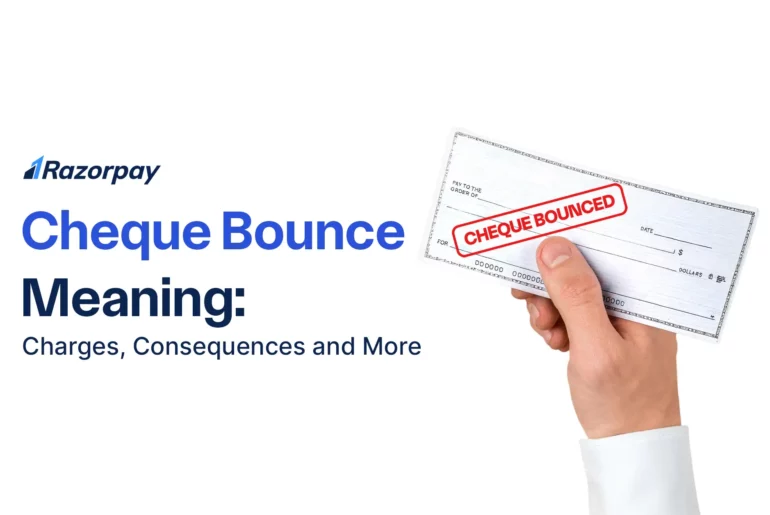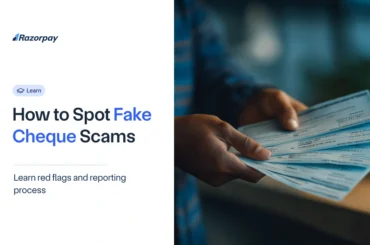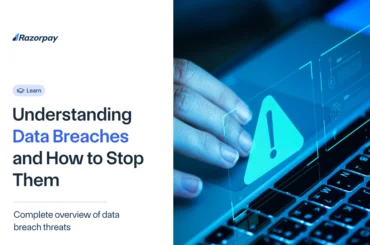Table of Contents
What is a Bounced Cheque?
A bounced cheque, also known as a dishonoured cheque, is a cheque that is rejected by the bank due to financial or non-financial reasons. Common causes include insufficient funds, incorrect date, signature mismatch, expired cheque, or stop payment request.
When a cheque bounces, the issuer may face bank penalties, legal action, and credit score damage, while the payee may struggle to recover the payment. Under Section 138 of the Negotiable Instruments Act, 1881, issuing a cheque without sufficient funds is a criminal offense, leading to fines or even imprisonment.
Related Read: Cheque vs Demand Draft
Common Reasons for a Cheque Bounce
Let’s explore the common reasons why a cheque bounce happens:
- Insufficient funds in the payer’s account.
- Mismatch in amount in words and digits written on the cheque.
- Discrepancies in the payer’s signature on the cheque and in the bank’s records.
- Stale cheques or expired cheques are cheques that have not been deposited into the bank within three months of the date of issue, and banks are not required to honour them, causing cheque bounce.
- Compromised cheques where the writing is illegible or the cheque in itself is damaged somehow are not honoured by banks.
What are the Consequences of a Bounced Cheque?
A bounced cheque can lead to severe financial, legal, and reputational consequences. It can result in penalties, legal action, and even impact your creditworthiness. Below is a detailed breakdown of what happens when a cheque is dishonoured.
Legal Consequences
- Cheque Bounce Notice: If a cheque bounces, the payee can send a legal notice to the payer within 30 days of receiving the cheque return memo. The payer has 15 days to clear the dues; failing which, the payee can file a legal case.
- Fines and Penalties: Under Section 138 of the Negotiable Instruments Act, 1881, the court may impose a fine of up to twice the cheque amount if the case is proven.
- Imprisonment: The payer can face up to two years of imprisonment if they fail to settle the dues after receiving a legal notice.
- Civil Suit: Apart from criminal charges, the payee can also file a civil suit to recover the cheque amount without involving criminal penalties.
- Additional Legal Action: In some cases, a bounced cheque can also be prosecuted under Section 420 or Section 406 of the Indian Penal Code (IPC) for fraud or breach of trust.
Impact on Credit Score
- A bounced cheque can negatively affect your credit score, making it harder to obtain loans, credit cards, or overdraft facilities.
- Financial institutions may perceive frequent cheque bounces as a sign of financial instability, leading to higher interest rates on future loans.
Bank Charges and Financial Penalties
- Bank Penalties: Banks impose penalties on both the payer and payee when a cheque bounces. The exact charges vary depending on the bank’s policies.
- Additional Charges: Merchants and financial institutions may refuse to accept cheques from individuals with a history of bounced payments.
Cheque Bounce Charges of Top Banks
Banks charge an NSF (Non-Sufficient Funds) charge whenever a cheque bounces due to the lack of funds in a drawer’s account. Apart from that, there are varying cheque bounce charges for different reasons. Let’s take a look:
| Bank | Outward Cheque | Inward Cheque | Technical Reasons |
| State Bank of India | Up to Rs 1 lakh: Rs 150 + GST
Above Rs 1 lakh: Rs 250 + GST |
For SME customers: Rs. 500 for first 3 cheques and Rs. 1000 for 4th cheque onwards (+ GST) For other customers: Rs 500 + GST per instance |
Rs 150+ GST |
| HDFC Bank | 1st cheque: Rs.400 2nd cheque: Rs 4503rd cheque onwards: Rs 500 |
Rs. 200 per instance | Rs 500 for NACH (National Automated Clearing House) returns Rs. 50 for non-financial reasons |
| ICICI Bank | Rs. 200 for financial reasons | Rs 500 for financial reasons Rs. 50 for non-financial reasons |
Rs. 500 for NACH returns |
| Punjab National Bank | Up to Rs. 1 lakh: Rs 150
Rs. 1 lakh – Rs. 10 lakhs: Rs. 250 Rs. 10 lakh onwards: Rs. 500 |
Up to Rs. 1 lakh: Rs. 200
Rs. 1 lakh- 1 crore: Rs 500 Rs. 1 crore onwards: Rs. 2000 for first cheque, Rs. 2500 for second cheque onwards |
Nil |
| Kotak Mahindra Bank | First cheque of the month: Rs. 350
2nd cheque onwards: Rs 750 |
Indian currency: Rs. 200
Foreign currency: Rs. 1000 |
Rs. 50 |
| Axis Bank | Rs. 500 per instance | Rs. 500 per instance | Rs. 500 per instance |
| Bank of Baroda | Up to Rs. 1 lakh: Rs. 250
Rs. 1 lakh to Rs. 1 crore: Rs. 500 Rs. 1 crore onwards: Rs. 750 |
Up to Rs. 1 lakh: Rs. 125
Rs. 1 lac to less than Rs. 1 crore : Rs. 250 Above Rs. 1 crore: Rs. 500 |
Rs. 250 |
Preventing Cheque Bounce (for the issuer)
There are certain preventative measures you can take as the payer to ensure that your cheque does not bounce. Let’s take a look at them:
- Maintain a sufficient balance in your bank account and verify beforehand that you have enough funds in your account before issuing a cheque.
- Verify all cheque details such as amount, date, account number, signature, etc. to ensure that there isn’t an inadvertent mistake.
- Issue a crossed cheque or a cheque with two parallel lines drawn either across the cheque or on the top-left corner of the cheque. Such a cheque can only be deposited into a bank account and cannot be cleared by a bank or any other financial institution, providing additional security to the payee.
- Leave an ample amount of time for the cheque to be cashed by the payee so that the cheque does not expire or go stale.
Responding to a Cheque Bounce Notice: What Next?
Receiving a cheque bounce notice can be intimidating. Let’s look at the measures you can take to avoid a cheque bounce penalty or cheque bounce punishment against you.
Carefully read through the notice
Understand the cause of the cheque bounce from the cheque bounce notice given to you by the payee. Verify all the details such as date, signature, amount, account number, etc. thoroughly.
Respond to the notice in a timely fashion
The general amount of time given to respond to a legal notice is 15 days. Try to draft a response to the payee within that time frame.
Ask for some time to pay back the cheque amount
After you get a cheque bounce notice, you should ideally get 15-30 days to settle the amount owed by you. If you fail to pay back within the stipulated time, it’ll give rise to cause for cheque bounce punishment.
Get a lawyer and build up a defense
A defense in a cheque bounce case can range from renouncing liability after the payment has been cleared through another payment mode, signature mismatch, proving wrongful presentation of the cheque to the bank by the payee, etc.
Taking Action on a Bounced Cheque (for the payee)
The following steps outline the actions you can take as the recipient to address a bounced cheque:
Initial Steps
- Ask the payer to cross-verify the details and validity of the cheque.
- Ensure the payer has sufficient funds in their bank account.
Non-compliance by the Payer
- If the payee refuses to re-issue the cheque or does not comply, issue a legal cheque bounce notice.
Cheque Return Memo
- Inform the payer that their cheque has bounced and cite the reason (financial or technical issues).
- Document this intimation through a legal cheque bounce notice within 30 days of receiving the cheque return memo from the bank.
Legal Cheque Bounce Notice
- This notice is in accordance with Section 138 of the Negotiable Instruments Act, 1881.
- Gives the payer 15 days to return the stipulated amount.
Pursuing Legal Action
- After one month of sending the cheque bounce notice, pursue legal action if the issue is unresolved.
- The cheque bounce case complaint can be filed in front of a Magistrate’s court.
- The payer will face cheque bounce punishment if convicted.
Initiating a Criminal Case
-
- File an FIR under Section 406 or Section 420 of the Indian Penal Code.
- The payer will be summoned to court, and hearings will proceed.
Latest Rule and Updates Regarding Cheque Bounce
The Negotiable Instruments (Amendment) Act, 2018 was officially passed on August 2, 2018, introducing two new provisions, Section 143A and Section 148. These provisions were included to better protect the rights of recipients and prevent the payers from weaponizing prolonged litigation.
Section 143A: Power to Order Interim Compensation
Section 143A allows the payee to receive interim compensation from the payer up to 20% of the cheque amount against a bounced cheque. This compensation is paid in two cases: a) when the payer pleads not guilty in a court of law during a trial or summon b) upon charges being framed in any other case, and can be recovered as a fine under Section 421 of the CrPC.
After the cheque bounce case has been settled in court with the payer being acquitted and not receiving cheque bounce punishment, the payer may receive a refund of the compensation amount along with interest at the prevailing rate.
Section 148: Appeal Against Conviction
- Appeals against convictions: Section 148 of the NI Act allows for appeals against trial court convictions.
- Deposit requirement: The appellate court can mandate a deposit of at least 20% of the fine or compensation imposed by the trial court under Section 421 of the CrPC.
- Additional deposit: This deposit is supplementary to any amount already paid under Section 143A.
- Disbursement of deposit: The deposited amount can be released to the complainant during the appeal process.
- Protection for appellant: The appellant can claim a refund of the deposited amount with interest if the appeal is successful, based on the RBI’s interest rate.
RBI Guidelines for Cheque Handling
- Minimum balance requirement: Customers who frequently use cheques must maintain a minimum balance in their accounts to prevent cheque bounces.
- 24/7 clearing house: The National Automated Clearing House for cheques will operate round-the-clock to expedite cheque processing.
Conclusion
Preventing cheque bounces is crucial to avoid financial penalties and legal troubles. By maintaining sufficient funds, verifying cheque details, and promptly addressing bounce notices, you can protect yourself. Understanding your rights and responsibilities, as well as staying updated on regulations, is essential for smooth cheque transactions.
Related Read: What Is an Account Payee Cheque?
FAQs
1. Can I avoid legal action if my cheque bounces?
You can avoid legal action by settling the cheque amount within 15 days of receiving the legal notice. Failure to do so can lead to legal proceedings. However, you can still get acquitted despite legal action if you build up a strong enough defense against the cheque bounce case.
2. Is there a difference between a bounced cheque and a dishonoured cheque?
Yes, a bounced cheque and a dishonoured cheque are similar but not exactly the same. A bounced cheque is a cheque which has not been processed due to the lack of sufficient funds in the payer’s account. A dishonored cheque, on the other hand, is a cheque that has not been processed due to technical reasons such as signature mismatch, illegible writing, discrepancies in cheque amount, etc.
3. Is cheque bounce a crime?
Yes, cheque bounce is considered a criminal offense under Section 138 of the Negotiable Instruments Act, 1881.
4. How many times can a cheque bounce?
There is no specific limit to how many times a cheque can bounce, but each instance may incur penalties and increase the risk of legal action. Moreover, banks may refuse to process a cheque if it has already bounced more than once or twice.
5. Can I file an FIR for a cheque bounce?
Yes, you can file an FIR under Sections 406 or 420 of the Indian Penal Code for criminal action in addition to pursuing a complaint under the Negotiable Instruments Act.
6. Can I be arrested in a cheque bounce case?
Yes, if found guilty, you can be arrested and face imprisonment for up to two years or a fine, or both, under Section 138 of the Negotiable Instruments Act, 1881.
7. Will bouncing a check damage my credit score?
Cheque bounce incidents are typically not reported to credit bureaus, so the chances of them affecting your credit score are minimal. However, frequent occurrences can damage your relationship with your bank and lead to other financial restrictions.
8. What are the documents required to file a cheque bounce case in India?
To file a cheque bounce case, you need the bounced cheque, the cheque return memo from the bank, the legal notice sent to the drawer, and proof of receipt of the notice.
9. What are the specific legal documents required to file a case for a bounced cheque?
To file a cheque bounce case, you need the bounced cheque, the cheque return memo from the bank, the legal notice sent to the drawer, and proof of receipt of the notice.





